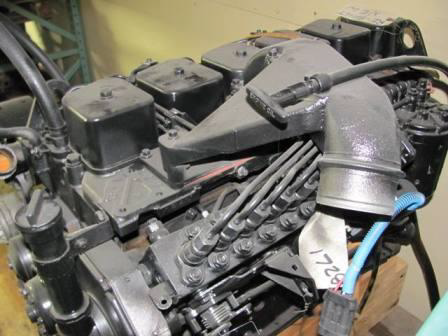Cummins® Engine Information
Posted by Diesel Conversion Specialists® on Nov 18th 2022
PICKING A CUMMINS® ENGINE
There are three types of fuel systems used on the 5.9 Cummins engines, and these differences are the only major aspects that set them apart from each other. The engines are universal as far as transmission mounting, if a tranny fits one engine, it will fit another (providing the proper adapter plate is used). For states with emissions inspections, the general rule is to go with an engine of the same year as, or newer than the implant truck. Check with your local emissions inspector for specific laws that apply to your project.
Some preferences to consider are fuel economy, horse power and torque, mechanical or electronically controlled fuel system, noise level, ease of installation, governed RPM limit, and purchase price.
Some customers have inquired about utilizing a Cummins industrial engine for their conversion. These industrial engines are used in school buses, dump trucks, tractors, and off-road equipment. While this type of engine may seem like a cheaper alternative, the cost and time it requires to update the engine for automotive use can be substantial. Please see below for further information.
For related technical or comparison data please see:
THE 12-VALVE
All 12-Valves are non-electronic injection pump engines and DO NOT require any electronics from the truck to run. The simplicity of the 12-Valve engine makes it the easiest to install, maintain, and most dependable.
RPM RANGE
|
0 - 2500 |
Bosch VE Rotary Pump1989-1993 Stock Equipment (most automotive applications) Max Stock Torque - 400 ft./lbs. @1600 RPM |
|
0 - 2700 |
Non-Modified P-7100 Pump | 1994-1998 Stock Equipment Max Stock Torque - 440 ft. /lbs.@1600 RPM |
|
0 - 4000 |
Modified Inline Pump |
"Rotary Pump" 12 Valve
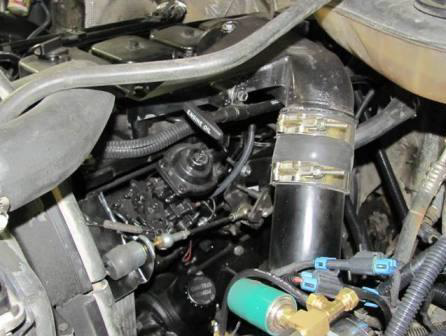
The 1989 - 1993 engines are readily available, inexpensive, get the best fuel economy stock, and have decent torque. These use the Bosch® VE "rotary," injection pump which can be adjusted to achieve a little more horse power. The 1989 - 1991½ are non-intercooled. The 1991½ and newer are all intercooled. The non-intercooled engines can be intercooled if desired; it is highly recommended if you plan to turn the power up any to control exhaust temperatures. It's possible to add 40-60 HP with an inexpensive fuel pin so intercooling can be quite desirable.
The 1993 and earlier engines usually have a diaphragm style vacuum pump which does not work as well as the later style pump if your truck uses vacuum for brake assist. The A/C compressor can also be an issue, as they are usually longer than the 1994 - 1998 versions, and use a different mounting bracket. Most A/C compressors from 1989 -1993 used R12 Refrigerant which is expensive and difficult to acquire. A few of the 1993 A/C compressor and A/C brackets are the same as the more conversion friendly 1994 - 1998 versions pictured below. The vacuum pump and power steering mounting bracket will interchange. In addition to the already mentioned differences, some of the early engines have a different fan support that is higher and more centered with the engine. These fan supports work ok in the 1969 - 1997 trucks, although the fan is too high for the stock fan shroud it is at least centered. It does not work so well in the 1999 and newer trucks as the fan will not fit under the radiator shroud, and the shroud cannot be raised as easily as the older trucks. We have been told from a few customers that it works ok in the 2003 - 2007 6.0L diesel shroud. The older style fan hub does not work if you plan on using the factory tachometer.
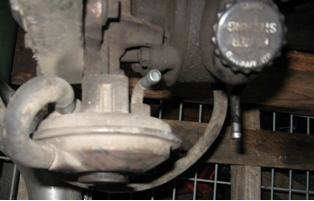 |
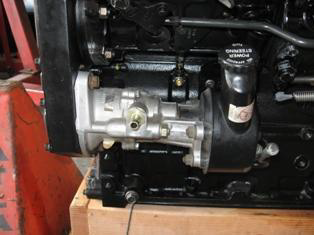 |
|
"Old" Style diaphragm vacuum pump |
"New" Style Vacuum pump |
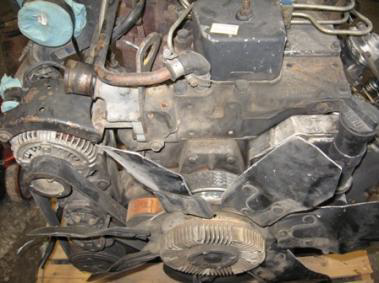 |
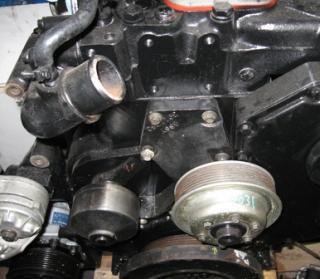 |
|
"Old" Style Fan support bracket and water neck |
"New" Style Fan support bracket and water neck" |
"P-Pump" 12 Valve
The 1994 - 1998 Engines offer good power and torque, as well as good fuel economy. These engines have the Bosch P7100 inline manual fuel pump which produces 160-215HP stock. With this pump, one can easily add 15-95HP by installing a fuel plate. These engines are possibly the most desirable 12-Valves because power upgrades are easily accomplished with fuel plate adjustments etc. If you get an extremely good deal on an earlier engine it may be cost effective to convert it to a P7100 pump if your desire is big Torque numbers.
There are many power upgrades that can be done to any of the 12-Valve engines without totally sacrificing fuel economy or reliability.
When using a Ford radiator that has the upper radiator connection on the passenger side, it is helpful to replace the thermostat housing with the housing we offer; it points straight up, so it makes the upper radiator hose connection easier. It includes a new thermostat and seals. When using this housing you will also need our Dodge alternator bracket. Radiators that have the upper hose connection on the driver side utilize the "new" style thermostat housing that points to the driver side of the truck.
THE 24-VALVE

RPM RANGE
|
0 - 3200 |
Max Stock Torque—505 ft./lbs. @ 1600 rpm |
To ensure proper runability the ECM and PCM must year match. If there is a mis-match you will encounter runability and other issues.
The 1998½ - 2002 24-Valve engines are computer controlled and provide a bit more horsepower than the earlier engines. The Dodge PCM is not required in order to use OBDII diagnostics but does require a professional grade scan tool in order to communicate through the data link connector. Without the Dodge PCM, diagnostic information can also be accessed at a Cummins dealer through the Cummins data link connector located in the engine wiring harness, but certain performance programmers will not work as a result.
The 2001-2002 engines require an electronic speed signal input to run properly. Ford trucks that have a rear axle speed sensor can easily accommodate this, and it can be done in an older truck with an aftermarket speed sensor. It’s just another thing you need to know.
Be aware that some of these engines have what is referred to as a "53 block." This number is cast onto the side of the block just above the oil pan rail on the rear driver’s side or front passenger side. These blocks are known to crack on the exterior water jacket.
The thermostat housing on these trucks also points toward the driver’s side of the truck, so if you plan to run a Ford radiator that has the upper hose connection on the passenger side of the radiator, you will want to buy our straight up thermostat housing to make your upper radiator hose connection easier.
DCS also offers a "Stand Alone" harness to make your Dodge Cummins 24 valve run in any chassis of your choice by simply adding power and ground.
To Determine which 24 valve engine you have, please reference your Cummins MAP sensor connector. See reference below:

THE "COMMON RAIL"
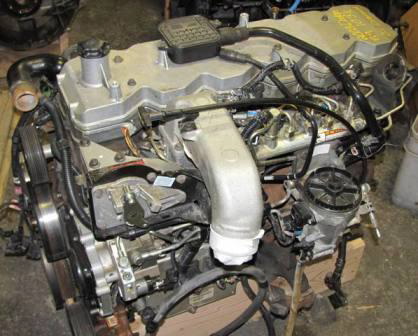
RPM RANGE
|
0 - 3200 |
Max Stock Torque- 555-650 lb-ft |
See our Common Rail Conversion Information article for more detailed information.
Cummins Common Rail 2003-2009, 5.9L/6.7L - Generation 3
The Cummins common rail engines are a great choice for your conversion. They offer great power and reliability. Engine tuning upgrades can be done electronically with several tuning service businesses existing in the US and Canada. Full engine diagnostic capabilities are also retained.
There are differences in the various model years you’ll want to be aware of before sourcing an engine. If you are unsure if your ECM is from an automatic or manual transmission truck we can verify this if you provide us with the ESN listed on the ECM. Below are some conversion related notes for your consideration.
2003-2004 with Manual Trans ECM:
- Original APPS (accelerator pedal position sensor) mounted under battery.
- ECM is compatible with DCS’s harness modification service and pedal module.
- Key recognition security system was optional on some models which may require a re-flash of the ECM.
2003-2004 with Automatic Trans ECM:
- Original APPS (accelerator pedal position sensor) mounted on engine. This is retained. Pedal kit is required to operate the engine mounted APPS.
- ECM is compatible with DCS harness modification service.
- Key recognition security system was optional on some models which may require a re-flash of the ECM.
- Must designate automatic trans engine is used if using DCS harness modification service. There are differences compared to the manual trans engine.
2005:
- Both the Automatic and Manual trans are compatible, however the Manual trans ECM has been reported to be more desirable for power & tuning.
- Key recognition security system was optional on some models which may require a re-flash of the ECM.
2006-2009 5.9 & 6.7 Liter:
- Dodge TIPM (Totally Integrated Power Module) is not required for OBD port communication (On Board Diagnostics) when using modern OBD scan devices.
- ECM re-flash necessary to eliminate SKIM (Sentry Key Immobilizer Module) security function.
2010 & Newer: Generation 4
- DCS currently does not offer technical support on these engines.
INDUSTRIAL CUMMINS ENGINES
We offer this information to make you aware there can be many differences between an Industrial Cummins engine vs. a Dodge Cummins engine. The cost and time switching these engines over can be substantial.
12 Valve Industrial Engines
Details that often differ from automotive style engines:
- injection pump
- timing cover
- turbo inlet/outlet
- throttle linkage & cable
- lower radiator hose nipple
- a/c compressor bracket
- fan support & pulley
- belt tensioner bracket
- oil pan & pickup tube
- exhaust manifold
- air horn
- lower compression ratio
24 Valve Industrial Engines
- Injection pump will not communicate with Dodge ECM
- No electronic tuning capabilities
- Much lower governed RPM is common (as low as 1,900 RPM!)
- fly-by-wire TPS (throttle position sensor incorporated in the accelerator pedal)
- Lower rad hose connection, a/c pump bracket
- Fan support/pulley
- Thermostat housing/alternator mount
- Belt tension bracket
- Oil pan and pickup tube (too long of a sump)
- Exhaust manifold
- Air horn (Intake)
- Factory diagnostics require Cummins Insight®
Possible Options to make an Industrial 24 Valve conversion-friendly:
1.) Use a mechanical injection pump from a 1994 -98 Dodge 12 Valve engine known as “P-pumping” the 24 Valve engine
2.) Get ALL of the DODGE electronic engine components (VP44, ECM, PCM, TPS & throttle cable)
Common Rail Industrial Engines
Our adapter plates will not work with the Common Rail industrial engines due to the engine’s rear-gear timing system.
*Diesel Conversions Specialists® is not affiliated with Cummins, Ford, or Dodge. Our uses of these trademarks are for descriptive purposes only.
Diesel Conversion Specialists®
www.dieselconversion.com
320.440.2900

